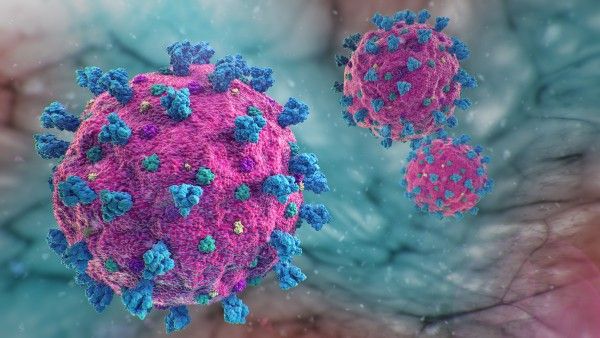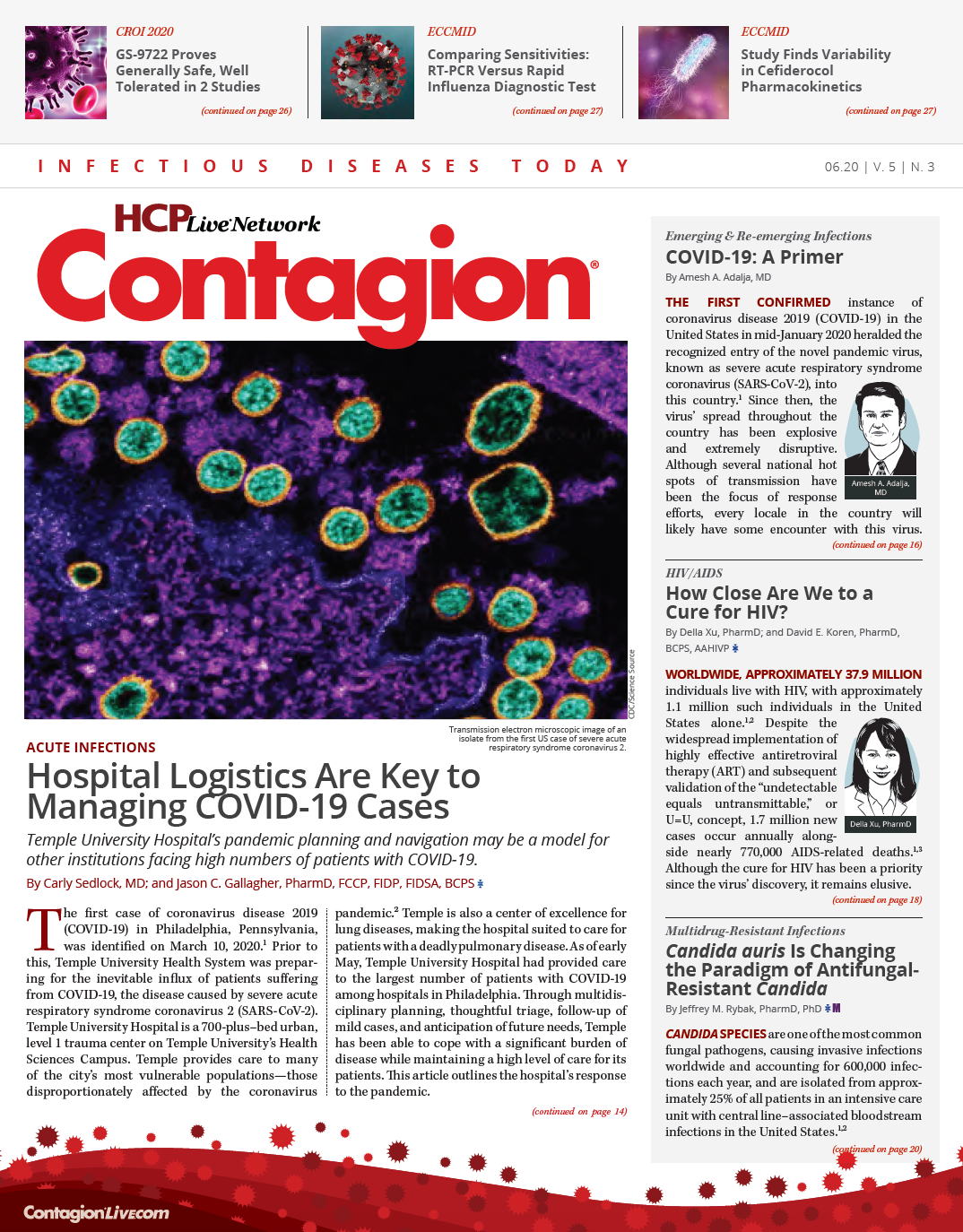COVID-19: A Primer
This virus has multiple facets and highlights a need for real-time learning.

The first confirmed instance of coronavirus disease 2019 (COVID-19) in the United States in mid-January 2020 heralded the recognized entry of the novel pandemic virus, known as severe acute respiratory syndrome coronavirus (SARS-CoV-2), into this country.1 Since then, the virus’ spread throughout the country has been explosive and extremely disruptive. Although several national hot spots of transmission have been the focus of response efforts, every locale in the country will likely have some encounter with this virus.
Below I will discuss the transmission, mortality, and clinical characteristics of the novel virus and compare and contrast it with SARS, Middle Eastern respiratory syndrome (MERS), and influenza.
THE VIRUS
SARS-CoV-2 was initially identified in a cluster of 41 individuals who developed pneumonia in Wuhan, China. The virus is the seventh human coronavirus identified. Coronaviruses are a large group of enveloped RNA viruses named for their characteristic appearance on an electron micrograph. The others include 4 viruses—229E, OC43, NL63, and HKU1—that generally cause mild symptoms of the common cold. Of these, HKU1 does appear to have the capacity to cause more severe disease.2 SARS-CoV and MERS-CoV are the other 2 and, by contrast, tend to cause severe disease and are closely linked to animal spillover events from palm civet cats and bats, respectively. Within the coronavirus family, SARS-CoV-2 is classified as a betacoronavirus, a cluster that also includes SARS-CoV and MERS-CoV, as well as HKU1 and OC43. The virus uses its spike protein to bind to its requisite receptor, which for SARS-CoV and SARS-CoV-2 is the angiotensin-converting enzyme 2, found on various cell types. This protein is also the focus of vaccine development efforts.2
TRANSMISSION
The virus appears to transmit primarily through the respi­ratory route in large droplets from the mouth and nose. Such droplets fall to the ground within about 6 feet of their point of emanation. They may land on surfaces and remain viable for some time depending on environ­mental conditions. As an enveloped virus, SARS-CoV-2 is not hardy. Concerns exist regarding airborne or aerosol transmission, but this appears to be more of an issue for health care facilities performing aerosol-generating proce­dures, such as the use of bilevel positive airway pressure (BiPAP), aerosol drug treatments, intubation, and bron­choscopy. Some concern also exists over fecal-oral trans­mission, but the frequency and circumstances of that form of transmission are not well characterized.3
Currently, the degree of seasonality that this virus may exhibit is unclear. The 4 community-acquired coronavi­ruses do exhibit seasonality; however, the novel virus, despite poor weather conditions for its surface viability, may be less seasonal given the lack of population immu­nity. Such low levels of immunity may be sufficient to overcome the diminished environmental viability and natural social distancing that occurs in warmer months in temperate climates.
CLINICAL CHARACTERISTICS
COVID-19, the disease caused by SARS-CoV-2, has a wide spectrum of illness, ranging from asymptomatic infection to fulminant respiratory disease leading to acute respira­tory distress syndrome (ARDS). According to case series, the most common signs and symptoms can include fever, chills, myalgias, and sore throat. Some individuals, in contrast with others with many other respiratory viral infections, may experience gastrointestinal symptoms such as nausea, vomiting, and diarrhea. Loss of smell and taste has also been reported.4,5
Although most patients have a mild course that does not require hospitalization, those with advanced age or other comorbid conditions may fare worse. Risk factors such as diabetes, hypertension, obesity, lung disease, immunosuppression, and cardiovascular disease can portend a worse prognosis.6
The presence of dyspnea, which can signify the pres­ence of pneumonia, may signal more severe symptoms. Pneumonia, which radiologists may not detect on an ordi­nary chest x-ray but only on a chest CT scan, is often described as having a ground-glass appearance.7
ARDS can ensue, and emerging data suggest the possi­bility of 2 phenotypes with different treatment impli­cations: one form, known as L, with preserved lung compliance, and another, H, with diminished lung compli­ance. Those with near-normal lung compliance (L form) may benefit from noninvasive ventilation options such as BiPAP and continuous positive airway pressure and when intubated may tolerate higher tidal volumes. Those with the H form, in which classic ARDS is present with bilat­eral infiltrates on chest radiography, should be treated with standard ARDS low-tidal volume protocols and may require prone-position ventilation.8
Another serious clinical manifestation is cardiomyop­athy (acute cardiac injury), which clinicians can diagnose via electrocardiogram, echocardiography, and troponin measurement.9 The novel virus has also been hypoth­esized to cause a thrombophilia-like condition char­acterized by a prothrombotic predisposition leading to microthrombi in digits as well as in the pulmonary vasculature. This is evidenced by elevated D-dimer levels as well as the development of antiphospholipid anti­bodies.9,10 Neurologic manifestations, including stroke and neuropathy, have also been reported in some patients.11
Laboratory abnormalities that may be present include leukopenia, lymphopenia, and elevated C-reactive protein, low procalcitonin, elevated lactate dehydrogenase, and elevated D-dimer levels. Elevated ferritin and IL-6 levels have also been observed and may be a signal of a hyperinflammatory state; patients with these laboratory abnormalities might be study candidates for anti—IL-6 (tocilizumab, sarilumab), anti– IL-1 (anakinra), and cytokine apheresis therapies.12
No recommended treatments for this virus exist, although clinical trials are ongoing, and the use of the antiviral remde­sivir has shown the ability to hasten clinical improvement in severe cases, which led to an emergency use authorization.13
MORTALITY
The mortality risk from COVID-19 is not currently known because the denomi­nator of infection is unclear. This uncertainty stems largely from variance in testing poli­cies and availability, which has introduced a severity bias in the data. The best estimates for infection fatality ratios all fall under 1.0%, with some as low as 0.66% and 0.37%. The relative risk of mortality increases substantially with each decade of life. The same is true for hospitalization ratios, which have been significantly influential in hospital capacity planning.
SARS, MERS, AND SEASONAL INFLUENZA COMPARISONS
A comparison of the novel virus with fellow coronavi­ruses SARS and MERS highlights some major differences. Although all are respiratory viruses with overlapping clinical syndromes, both SARS and MERS have consid­erably higher mortality risks. Approximately 10% of patients with SARS and over 30% of those with MERS succumbed to their illness. SARS and MERS, however, do not exhibit the efficient human-to-human transmis­sibility of the novel virus and are better characterized as zoonotic viruses with poor efficiency in transmis­sion between humans. Seasonal influenza also has clin­ical symptoms similar to those of the novel virus and exhibits efficient human-to-human transmission. However, because of population-level immunity to influenza, it has a lower attack rate season to season. Its mortality ratio is likely 0.1%, although it can be significantly higher in older populations.
As the novel coronavirus pandemic continues, the clin­ical and scientific knowledge base will increase dramati­cally. Critically, clinicians will need to keep abreast of all new developments to optimize patient care.
Adalja, a senior scholar at the Johns Hopkins Center for Health Security in Baltimore, Maryland, is board certified in infectious disease, critical care medicine, emergency medicine, and internal medicine. His research focuses on biosecurity, emerging infectious disease, and pandemic preparedness.
References:
- Holshue ML, DeBolt C, Lindquist S, et al. First case of 2019 novel coronavirus in the United States. N Engl J Med 2020; 382:929-936.
- Huang C, Wang Y, Li X, et al. Clinical features of patients infected with 2019 novel coronavirus in Wuhan, China. Lancet 2020; 395: 497-506.
- Omer SB, Malani P, del Rio C. The COVID-19 pandemic in the US. JAMA 2020; doi:10.1001/jama.2020.5788
- Del Rio C. Malani PN. 2019 novel coronavirus—important information for clinicians. JAMA 2020; 323: 1039-1040.
- Ollarves-Carrero MF, Rodriguez-Morales AG, Bonilla-Aldana DK, et al. Anosmia in a healthcare worker with COVID-19 in Madrid, Spain. Travel Med Infect Dis 2020. https://www.researchgate.net/profile/Alfonso_Rodriguez-Morales/publication/340488551_Anosmia_in_a_Healthcare_Worker_with_COVID-19_in_Madrid_Spain/links/5e8ca17b92851c2f52884dcc/Anosmia-in-a-Healthcare-Worker-with-COVID-19-in-Madrid-Spain.pdf. Accessed April 13, 2020.
- Garg S, Kim L, Whitaker M, et al. Hospitalization Rates and Characteristics of Patients Hospitalized with Laboratory-Confirmed Coronavirus Disease 2019 — COVID-NET, 14 States, March 1—30, 2020. MMWR Morb Mortal Wkly Rep. ePub: 8 April 2020. DOI: http://dx.doi.org/10.15585/mmwr.mm6915e3external icon.
- Yoon SH, Lee KH, Kim JY, et al. Chest radiographic and CT findings of the 2019 novel coronavirus disease (COVID-19): analysis of nine patients treated in Korea. Korean J Radiol 2020. 21: 494-500.
- Gattinoni L. et al. COVID-19 pneumonia: different respiratory treatment for different phenotypes? (2020) Intensive Care Medicine; DOI: 10.1007/s00134-020-06033-2.
- Zhou F, Yu T, Du, Ronghui D, et al. Clinical course and risk factors for mortality of adult inpatients with COVID-19 in Wuhan, China: a retrospective cohort study. Lancet 395: 1054-1062.
- Zhang Y, Xiao M, Zhang S, et al. Coagulopathy and antiphospholipid antibodies in patients with COVID-19. N Engl J Med 2020. DOI: 10.1056/NEJMc2007575.
- Mao L, Jin H, Wang M, et al. Neurologic manifestations of hospitalized patients with coronavirus disease 2019 in Wuhan, China. JAMA Neurology 2020; doi:10.1001/jamaneurol.2020.1127.
- Mehta P, McAuley DF, Brown M, et al. COVID-19: consider cytokine storm syndromes and immunosuppression. Lancet 2020; 395: 1033-1034.
- Bhimraj A, Morgan RL, Shumaker AH. Infectious Disease Society of America guidelines on the treatment and management of patients with COVID-19. https://www.idsociety.org/practice-guideline/covid-19-guideline-treatment-and-management/. Accessed April 13, 2020.

